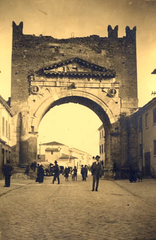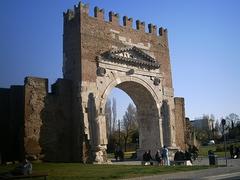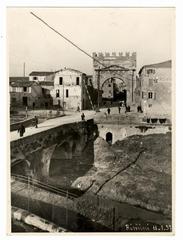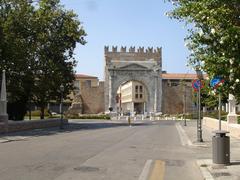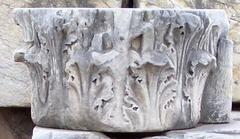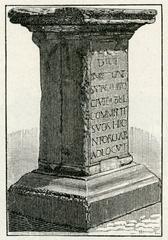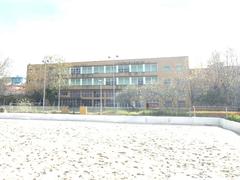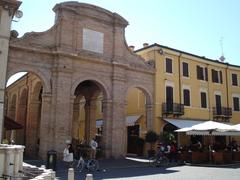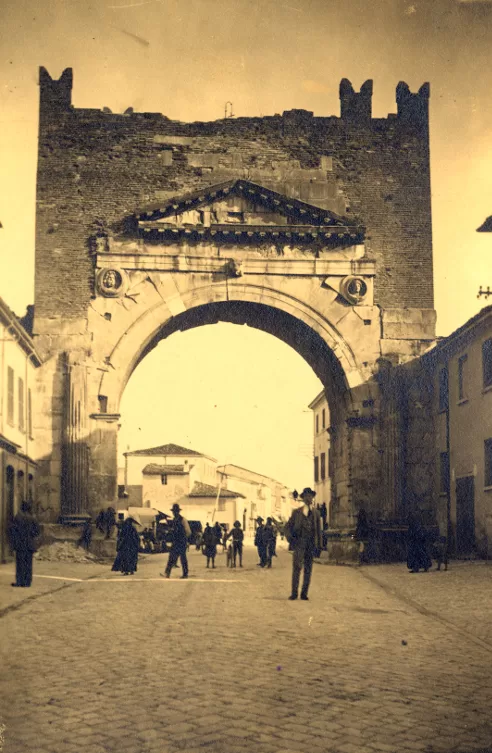
Arch of Augustus Rimini, Italy: Complete Guide to Visiting Hours, Tickets, History & Nearby Attractions
Date: 14/06/2025
Introduction
The Arch of Augustus in Rimini, Italy, stands as the oldest surviving Roman triumphal arch in the country, a powerful symbol of the city’s enduring Roman heritage and a testament to ancient architectural ingenuity. Erected in 27 BCE by decree of the Roman Senate to honor Emperor Augustus, this monument marks both the end of the Via Flaminia and the beginning of Rimini’s ancient urban core. Today, the arch is not only a tangible link to the grandeur of the Roman Empire but also a vibrant centerpiece of Rimini’s historic and social life. This comprehensive guide details the arch’s history, architectural features, practical visiting information, and its significance within Rimini’s cultural landscape. (Rimini Turismo; Tourist Places Guide; Travel Emilia Romagna)
Contents
- Introduction
- Historical Background and Construction
- Architectural Features and Symbolism
- Preservation, Restoration, and Cultural Legacy
- Practical Visitor Information
- Visiting Hours
- Tickets and Accessibility
- Getting There
- Nearby Attractions
- Guided Tours and Special Events
- Visitor Tips
- Frequently Asked Questions (FAQ)
- Visuals and Media
- Summary and Final Recommendations
- Sources
Historical Background and Construction
Commissioned in 27 BCE to celebrate both the end of decades-long civil wars and Augustus’s role as a peacemaker, the Arch of Augustus originally stood as the monumental city gate at the southern entrance of Ariminum (modern Rimini). Its placement at the terminus of the Via Flaminia, a critical Roman road linking Rome to the Adriatic Sea, underscored Rimini’s strategic importance as a crossroads between Rome and the northern provinces. The arch simultaneously functioned as a ceremonial gateway, a statement of imperial power, and a celebration of urban renewal. (Rimini Turismo)
Constructed from durable Istrian limestone, the arch measures approximately 9.92 meters in height and 8.45 meters in width, with a central archway almost 8.84 meters tall—dimensions that allowed for the passage of chariots and grand processions. (ItalyGuides.it)
Architectural Features and Symbolism
Structure and Decoration
The arch features a single monumental archway, flanked by engaged Corinthian columns on high pedestals. These columns support an entablature and an attic that once bore a dedicatory inscription to Augustus. Fragments of this inscription remain visible today, commemorating both the emperor’s virtues and the restoration of vital roads.
Iconography
Richly symbolic reliefs adorn the arch:
- Roman Deities: Sculpted medallions depict Jupiter, Neptune, Apollo, and Roma, representing the emperor’s divine favor, Rome’s dominion over land and sea, and Rimini’s privileged status within the empire.
- Keystone and Frieze: The keystone features Augustus himself, a powerful emblem of his semi-divine status. Laurel wreaths and bucrania (ox skulls) on the frieze evoke themes of victory and religious piety.
- Attic Statuary: The attic originally supported a monumental statue of Augustus in a quadriga, now lost to history.
Urban Placement
The arch was intentionally constructed without gates as a symbol of peace, reflecting the Pax Romana. Later, during the Middle Ages, battlements were added, incorporating the arch into the city’s defensive walls—a reminder of Rimini’s evolving urban and military history. (UNESCO World Heritage)
Preservation, Restoration, and Cultural Legacy
Over two millennia, the Arch of Augustus has survived natural aging, urban development, and wartime destruction—emerging as one of Rimini’s most recognizable landmarks. Medieval adaptations, such as the addition of battlements, reflect the city’s shifting priorities, while modern restoration efforts in the 18th and 19th centuries focused on stabilizing the masonry and removing non-original elements.
Today, the arch is protected as a national monument and remains a focal point for civic celebrations, historical commemorations, and local identity. It is featured on Rimini’s coat of arms and continues to inspire artists, architects, and historians alike. The arch’s integration into Rimini’s daily life and urban layout makes it not only a relic of antiquity but a living symbol of continuity and community. (Rimini Turismo)
Practical Visitor Information
Visiting Hours
The Arch of Augustus is an open-air monument located in a public square and is accessible to visitors 24 hours a day, year-round. The arch is beautifully illuminated from dusk until midnight, especially during the summer months (April–October), making evening visits particularly atmospheric. (Full Suitcase)
Tickets and Accessibility
- Admission: Free of charge; no tickets or reservations required.
- Accessibility: The site is fully wheelchair accessible, with smooth, paved pedestrian areas surrounding the arch.
- Facilities: Benches, shaded areas, cafés, and restrooms are available nearby.
Getting There
- Location: The arch stands at the southern gateway of Rimini’s historic center, at the intersection of Corso d’Augusto and Via XX Settembre.
- By Foot: Approximately 10–15 minutes from Rimini’s main train station.
- Public Transport: Local buses stop nearby.
- Parking: Paid lots are available on the outskirts of the old town, with clear signs directing visitors to the historic center. (Full Suitcase)
Nearby Attractions
- Tiberius Bridge: Another Roman marvel at the opposite end of Corso d’Augusto.
- Piazza Cavour: Rimini’s main square, lined with historic buildings and lively markets.
- Malatestiano Temple: A Renaissance church renowned for its art and architecture.
- Roman Amphitheater: Remnants of Rimini’s ancient entertainment venues.
- Castel Sismondo: A 15th-century fortress now used as an exhibition space.
Guided Tours and Special Events
- Guided Tours: Available through the Rimini Tourism Office and local operators, often in multiple languages. Tours typically include the arch and other key historical sites.
- Cultural Events: The arch frequently serves as a backdrop for local festivals, markets, and historical reenactments, especially during summer. Check the Rimini Tourism Board for upcoming events.
Visitor Tips
- Best Time to Visit: Early mornings and late afternoons offer optimal lighting and fewer crowds.
- Photography: The arch is especially photogenic at sunrise, sunset, and when illuminated at night.
- Respect the Site: Climbing or touching the monument is prohibited to protect its preservation.
- Language: English is widely spoken, but learning a few Italian phrases enhances the experience.
- Safety: The area is safe and well-patrolled, but standard travel precautions apply.
Frequently Asked Questions (FAQ)
Q: What are the visiting hours for the Arch of Augustus?
A: The site is accessible 24 hours a day, year-round.
Q: Is there an admission fee or are tickets required?
A: No, admission is free and no tickets are required.
Q: Are guided tours available?
A: Yes, guided tours can be booked through the Rimini Tourism Office and local tour providers.
Q: Is the site accessible for disabled visitors?
A: Yes, the area features flat, paved walkways suitable for wheelchairs and strollers.
Q: What are the best times to visit?
A: Early mornings, late afternoons, and evenings for ideal lighting and fewer visitors.
Visuals and Media
For a richer experience, visitors are encouraged to view high-quality images and virtual tours on the official Rimini tourism website and travel platforms. Descriptive panels and QR codes on-site provide historical context in multiple languages. For SEO purposes, use alt tags such as “Arch of Augustus Rimini at sunset” or “Historic Roman Arch Rimini entrance” for digital images. (Travel Emilia Romagna)
Summary and Final Recommendations
The Arch of Augustus in Rimini is not only a relic of the Roman Empire but a living emblem of the city’s layered past and vibrant present. Its impressive state of preservation, rich iconography, and strategic location at the heart of Rimini’s historic district make it a must-see for any visitor. With free, round-the-clock access, full accessibility, and proximity to other major attractions, the arch is ideal for both spontaneous stops and as the starting point for in-depth historical explorations. Whether you visit during a quiet morning walk, a guided historical tour, or an illuminated evening, the arch invites you to connect with Rimini’s Roman roots and contemporary culture.
For up-to-date information, event listings, and audio guides, download the Audiala app and check the official tourism websites. Plan your visit today and experience firsthand one of Italy’s most remarkable ancient monuments.
Sources and Further Reading
- Arch of Augustus Rimini: Visiting Hours, Tickets, and Historical Insights, 2025, Rimini Turismo (Rimini Turismo)
- Visiting the Arch of Augustus in Rimini: Hours, Tickets, and Historical Insights, 2025, Tourist Places Guide (Tourist Places Guide)
- Arch of Augustus Rimini: Visiting Hours, Tickets, and Historical Guide to Rimini’s Iconic Monument, 2025, Travel Emilia Romagna (Travel Emilia Romagna)
- Visiting the Arch of Augustus Rimini: Hours, Tickets, History & Travel Tips, 2025, Full Suitcase (Full Suitcase)
